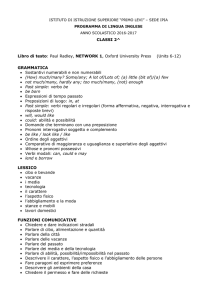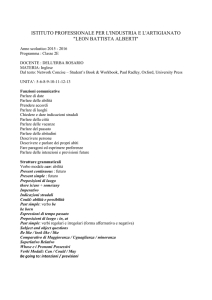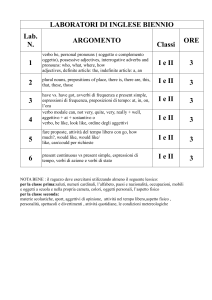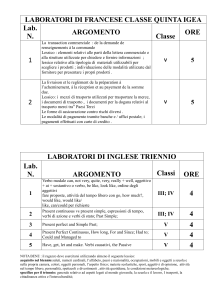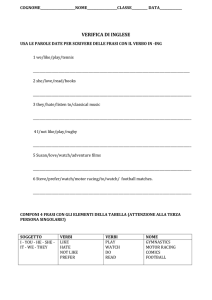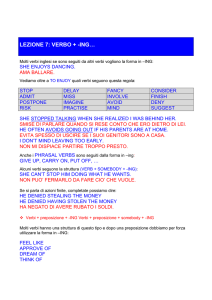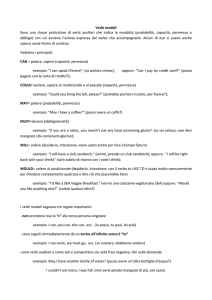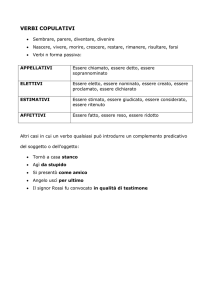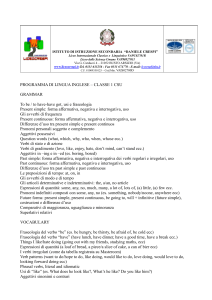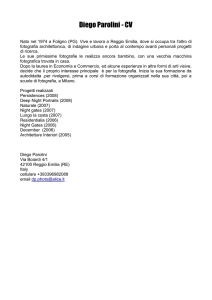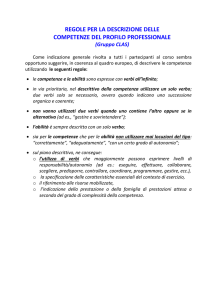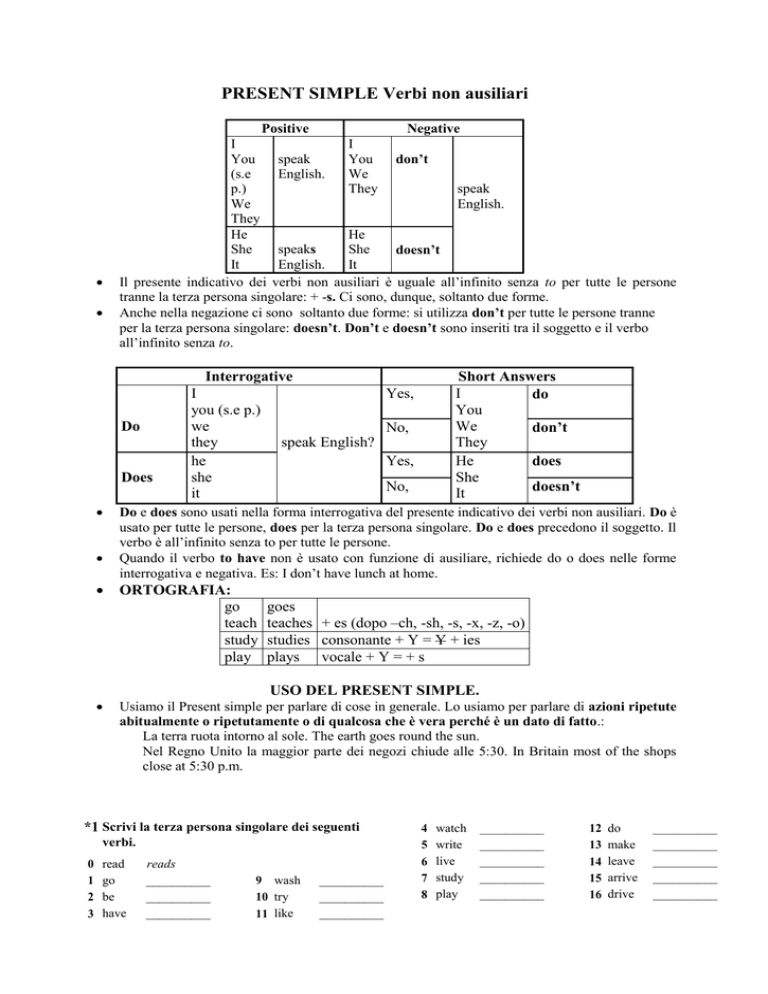
PRESENT SIMPLE Verbi non ausiliari
Positive
Negative
I
I
You
speak
You
don’t
(s.e
English.
We
p.)
They
speak
We
English.
They
He
He
She
speaks
She
doesn’t
It
English.
It
Il presente indicativo dei verbi non ausiliari è uguale all’infinito senza to per tutte le persone
tranne la terza persona singolare: + -s. Ci sono, dunque, soltanto due forme.
Anche nella negazione ci sono soltanto due forme: si utilizza don’t per tutte le persone tranne
per la terza persona singolare: doesn’t. Don’t e doesn’t sono inseriti tra il soggetto e il verbo
all’infinito senza to.
Interrogative
Do
Does
I
you (s.e p.)
we
they
he
she
it
Yes,
No,
speak English?
Yes,
No,
Do e does sono usati nella forma interrogativa del presente indicativo dei verbi non ausiliari. Do è
usato per tutte le persone, does per la terza persona singolare. Do e does precedono il soggetto. Il
verbo è all’infinito senza to per tutte le persone.
Quando il verbo to have non è usato con funzione di ausiliare, richiede do o does nelle forme
interrogativa e negativa. Es: I don’t have lunch at home.
ORTOGRAFIA:
go
teach
study
play
goes
teaches + es (dopo –ch, -sh, -s, -x, -z, -o)
studies consonante + Y = Y + ies
plays vocale + Y = + s
USO DEL PRESENT SIMPLE.
Usiamo il Present simple per parlare di cose in generale. Lo usiamo per parlare di azioni ripetute
abitualmente o ripetutamente o di qualcosa che è vera perché è un dato di fatto.:
La terra ruota intorno al sole. The earth goes round the sun.
Nel Regno Unito la maggior parte dei negozi chiude alle 5:30. In Britain most of the shops
close at 5:30 p.m.
*1 Scrivi la terza persona singolare dei seguenti
verbi.
0
1
2
3
Short Answers
I
do
You
We
don’t
They
He
does
She
doesn’t
It
read
go
be
have
reads
__________
__________
__________
9 wash
10 try
11 like
__________
__________
__________
4
5
6
7
8
watch
write
live
study
play
__________
__________
__________
__________
__________
12
13
14
15
16
do
make
leave
arrive
drive
__________
__________
__________
__________
__________
*2 Completa il testo con la forma affermativa
del Present simple dei verbi tra parentesi.
Every morning my wife and I 1_________ (wake
up) at 6.30 a.m. when my alarm clock rings. My
wife 2__________ (get up) immediately and
3
_______ (have) a shower, but I stay in bed and
4
__________ (listen) to the radio for 15 minutes. We
5
_________ (have) breakfast at 7.15, and I 6_______
(read) the newspaper.
I 7________ (work) in a bank, and I 8______ (go) to
work by train. The train 9________ (leave) at 8 a.m.,
and 10_________ (take) 45 minutes. My wife
11
_______ (be) a teacher. She 12_________ (go) to
work by bicycle. School 13________ (start) at 9
a.m., but she 14________ (get) to school at 8.15 a.m.
*3 Rileggi il testo dell’esercizio 2 e correggi le
frasi usando la forma corretta affermativa o
negativa del Present simple.
0 Bobby gets up at 6.15 a.m.
Bobby doesn’t get up at 6.15 a.m. He gets up at
1
2
3
4
5
6
7
8
6.45 a.m.
The alarm clock rings at 7 a.m.
His wife has a bath.
His wife listens to the radio.
They have breakfast at 7.30.
Bobby reads a magazine.
Bobby works in a school.
He walks to work.
Bobby’s wife is a doctor.
*4 Completa le frasi con Do o Does.
1 ___________ they like studying English?
2 ___________ Susan drink coffee for breakfast?
3 ___________ Jenny and John visit their parents
at Christmas?
4 ___________ you go to work by car?
5 ___________ the cinema open at 6 p.m.?
6 ___________ your parents work on Saturdays?
7 ___________ our English lessons start at 10
o’clock?
8 ___________ the train leave from platform 6?
*5 Trasforma le frasi in domande, e aggiungi
una short answer.
0 I don’t like skiing. (No)
Do you like skiing? – No, I don’t.
1 They live in Milan. (Yes)
2 She works for IBM. (No)
3 Max and Sam have a new car. (Yes)
4
5
6
7
8
We go to France for our holidays. (Yes)
John’s mother doesn’t play tennis. (No)
I don’t get up early. (No)
You need an umbrella. (Yes)
Her husband speaks French and German. (Yes)
*6 Completa il dialogo con la forma corretta
(affermativa, negativa o interrogativa) del
Present simple dei verbi tra parentesi o con
una short answer.
A 1________ (you / live) near here?
B No, I 2_______ . But I 3_______ (work) in the
local school.
A Really? 4_________ (you / like) your job?
B Yes, I 5________ (love) it. My children 6_____
(study) at the school too. 7 _________ (you /
have) children?
A Yes, I 8________ (have) a son. But he 9______
(not go) to this school. He 10________ (study)
Medicine at University.
B That’s interesting. 11_________ (he / enjoy) it?
A Yes, he 12______ . I 13_________ (not see) him
very often. He only 14_________ (come) home
once every three months.
PREPOSITIONS of TI ME
in
on
the morning
Monday
the afternoon
(morning)
the evening
1st May
December
Summer
2005
the 1980s
the 19th century
the Renaissance
at
six o’clock
night
lunchtime
Christmas
the weekend
the moment
the same time
Si usa in per parti del giorno, mesi, stagioni, anni, secoli e periodi storici.
Si usa on per i giorni della settimana e le date.
Si usa at per le ore, le festività, night, i momenti della giornata e altre espressioni di tempo.
1 Scrivi la preposizione corretta (in, on, at) per ogni espressione di tempo.
4 o’clock
0 at
1 _____ the afternoon
7 _____ my birthday
2 _____ Monday
8 _____ 1960
3 _____ June
9 _____ 9.30 a.m.
nd
4 _____ the 22 March 10 _____ night
5 _____ 2003
11 _____ Sunday evening
6 _____ midnight
12 _____ Christmas day
46
2 Inserisci le parole/espressioni nella casella
corretta.
Sunday - May - the morning - 3.30 - the evening
- the afternoon - five o’clock - June - midday midnight - night - Monday morning - 9.00pm - half
past two - Friday - quarter to nine
in
on
at
Sunday
3 Completa con le preposizioni di tempo.
Ex.: I’ve got an appointment with him .on... 4th May.
1 I go to the gym ............ Monday and ............Thursday ............ three ............ the afternoon. I
only go ............ winter because ............ summer I go to the swimming pool ............ the evening.
2 My birthday is ......... June 20th. On that day I get up early ......... the morning, usually ............
seven because I’m very excited.
3 ......... the weekend we relax. ......... Saturday evening we always go to the pub and ......... Sunday
afternoon we meet friends and ......... the evening we stay at home.
4 ......... Christmas we like meeting all our relatives.
5 Henry always go to bed late ......... night, usually ......... midnight.
6 I was born ......... 1993 ......... July.
7 Shall we go out ............ Friday? Shall we meet ......... nine?
8 I’ve got an appointment ......... midday.
9 There’s nothing to do ......... a rainy day like today.
10 Where were you ......... June 14th?
11 I had a cool night ............ New Year’s Eve.
PREFERENCES
LIKE, LOVE, ENJOY, HATE, PREFER, DISLIKE esprimono piacere / dispiacere e sono
seguiti dalla –ing form del verbo.
The –ing form
FORMA BASE
read
go
write
live
come
see
agree
sit
run
swim
forget
prefer
stop
listen
allow
FORMA -ING
reading
going
writing
living
coming
seeing
agreeing
sitting
running
swimming
forgetting
preferring
stopping
listening
allowing
travel
compel
play
study
die
lie
travelling
compelling
playing
studying
dying
lying
SPELLING RULES
-e muta = e + -ing
-e non muta = + ing
1 consonante preceduta da vocale accentata=
doppia consonante + -ing
-w oppure 1 consonante preceduta da vocale
non accentata = + -ing
-l = ll + -ing
-y = + ing
-ie = ie + ying
USO
La forma –ing si usa come se fosse un sostantivo:
- dopo le preposizioni. He’s good at dancing. E’ bravo a ballare
- per sostantivare un verbo. My hobbies are reading and singing. I miei hobby sono la
lettura e il canto.
- dopo il verbo go per descrivere un’attività. Let’s go swimming. Andiamo a nuotare.
- dopo i verbi like, love, prefer, hate. I like watching TV. Mi piace guardare la TV.
Si può usare l’infinito dopo like ma è meno comune. Di solito descrive una routine.
I like playing football. Mi piace giocare a calcio.
I like to play on Saturday. Mi piace giocare il sabato.
4 Osserva la tabella e scrivi delle frasi usando i
0 Sue / swim
Sue loves swimming.
suggerimenti e i verbi love, like o hate.
1 Alan / read
__________________
2 Liz / go to the theatre
__________________
3 Henry / ski
__________________
4 Liz and Sue / go shopping
__________________
5 Liz / fly
__________________
6 Alan / play with
__________________
his computer
TELLING THE TIME
Il modo più comune di dire l’ora nell’inglese parlato è il seguente:
Le ore sono espresse al singolare.
Per le ore intere si usa l’espressione o’clock.
What’s the time?
It’s seven o’clock.
What time is it?
Se necessario, si può precisare anche il momento della giornata: in the morning, in the
afternoon, in the evening o at night, oppure usare le abbreviazioni a.m. (ante meridiem),
da mezzanotte a mezzogiorno, e p.m. (post meridiem), da mezzogiorno a mezzanotte.
It’s two o’clock in the morning / at night
Sono le due del mattino / di notte.
o N.B. Non si usano a.m. e p.m. quando le ore vengono espresse con o’clock, past, to
ecc.
I minuti precedono le ore. La parola minutes di solito è omessa per
cinque.
Si usano:
o past per la prima mezz’ora
It’s five past two.
o to dalla mezz’ora all’ora successiva.
It’s five to two.
o (a) quarter past per il primo quarto d’ora. It’s (a) quarter past
five
o (a) quarter to per l’ultimo quarto d’ora
o half past per la mezz’ora
cinque e multipli di
Sono le 02:05
Sono le 01:55
Sono le 05:15
It’s (a) quarter to five Sono le 04:45
It’s half past seven. Sono le 07:30
In orari di treni, aerei, annunci ufficiali si usano di solito le ore da 1 a 24.
The 16:05 (sixteen oh five) train to Glasgow leaves from the platform 8.
Il treno delle 16:05 per Glasgow parte dal binario 8.
Ricorda:
morning si usa per il periodo tra mezzanotte e mezzogiorno;
afternoon si usa da mezzogiorno alle 17:00 o 18:00
evening si usa dopo le 17:00 o le 18:00 e fino a mezzanotte;
night si usa per “notte” ma viene anche usato per indicare la sera: last night è un altro modo per
dire yesterday evening;
at midnight = a mezzanotte;
at midday = a mezzogiorno.
1 Scrivi i seguenti orari per esteso in base al sistema dell’inglese parlato e ufficiale.
0. 8:00
eight o’clock in the morning
eight
1. 9:15
2. 10:30
3. 11:45
4. 12:50
5. 14:25
6. 6:35
7. 23:55
8. 1:11
9. 19:00
DATE
In inglese la data viene normalmente espressa con il numero ordinale.
La data si può leggere in due modi diversi:
2nd January
the second of January (UK)
nd
Juary 2
January the second (USA)
L’articolo the che precede il numero ordinale va sempre pronunciato anche se non scritto, così come
la preposizione of:
25 April
the twenty-fifth of April
I nomi dei mesi e dei giorni della settimana iniziano sempre con la lettera maiuscola.
Quando la data è complemento di tempo viene preceduta dalla preposizione on:
On 5th August we arrived in Berlin.
Il 5 agosto siamo arrivati a Berlino.
Gli anni si leggono a coppie.
1984
nineteen eighty-four
1566
fifteen sixty-six
1087
ten eighty-seven
410 A.D.
four ten A.D. (Anno Domini)
54 B.C.
fifty-four B.C. (Before Christ)
Fanno eccezione i primi nove anni di un secolo, in cui lo zero si dice oh oppure hundred/thousand
1901
nineteen oh one / nineteen hundred and one
1500
fifteen hundred
1002
ten oh two / one thousand and two
1902
two thousand
1003
two thousand and four
1501
two thousand and ten
Per i secoli si usano i numeri ordinali:
the 20th century
the twentieth century
st
the 1 century B.C.
the first century B.C.
ORDINAL NUMBERS
I numeri ordinali inglesi si formano aggiungendo il suffisso –th ai numeri cardinali corrispondenti,
con alcune variazioni nell’ortografia e nelle abbreviazioni.
Fanno eccezione i primi tre ordinali (e i loro composti) che hanno forme proprie: first, second,
third.
1st
first
11th eleventh
21st twenty-first
40th fortieth
th
nd
nd
2
second
12
twelfth
22 twenty-second
50th fifieth
3rd
third
13th thirteenth
23rd twenty-third
60th sixtieth
th
th
th
4
fourth
14
fourteenth
24 twenty-fourth
70th seventieth
5th
fifth
15th fifteenth
25th twenty-fifth
80th eightieth
th
th
th
6
sixth
16
sixteenth
26 twenty-sixth
90th ninetieth
7th
seventh
17th seventeenth
27th twenty-seventh
100th hundredth
th
th
th
8
eighth
18
eighteenth
28 twenty-eighth
th
th
9
ninth
19
nineteenth
29th twenty-ninth
10th tenth
20th twentieth
30th thirtieth
I numeri ordinali si usano:
come in italiano
per indicare re e regine
Henry VIII
-> Henry the Eighth
King Charles I -> King Charles the First
per le date e i secoli (vedi sopra)
Qual è la data delle seguenti festività? Scrivila per esteso come nell’esempio.
0. Christmas Day is on the twenty-fifth of December
1. New Year’s Eve is on the
2.
St. Valentine’s Day is on the
3.
All Saints’ Day is on the
4.
The longest day of the year is the
5.
Halloween is on the
6.
American Independence Day is on the
Traduci le seguenti frasi.
0. Il compleanno di Olivia è il 1 febbraio. Olivia’s birthday is on the first of February.
1. Elisabetta I nacque il 7 settembre 1533.
2.
Bob sarà in vacanza dal 22 al 31 agosto.
3.
Il nuovo negozio aprirà lunedì 8 luglio.
4.
I miei genitori erano a scuola negli anni Settanta.
5.
Shakespeare morì il 23 aprile 1616.

